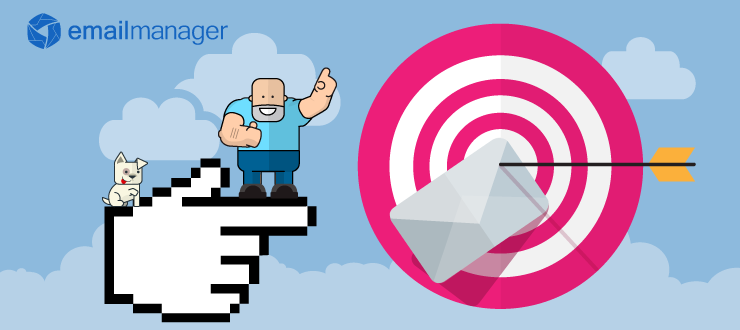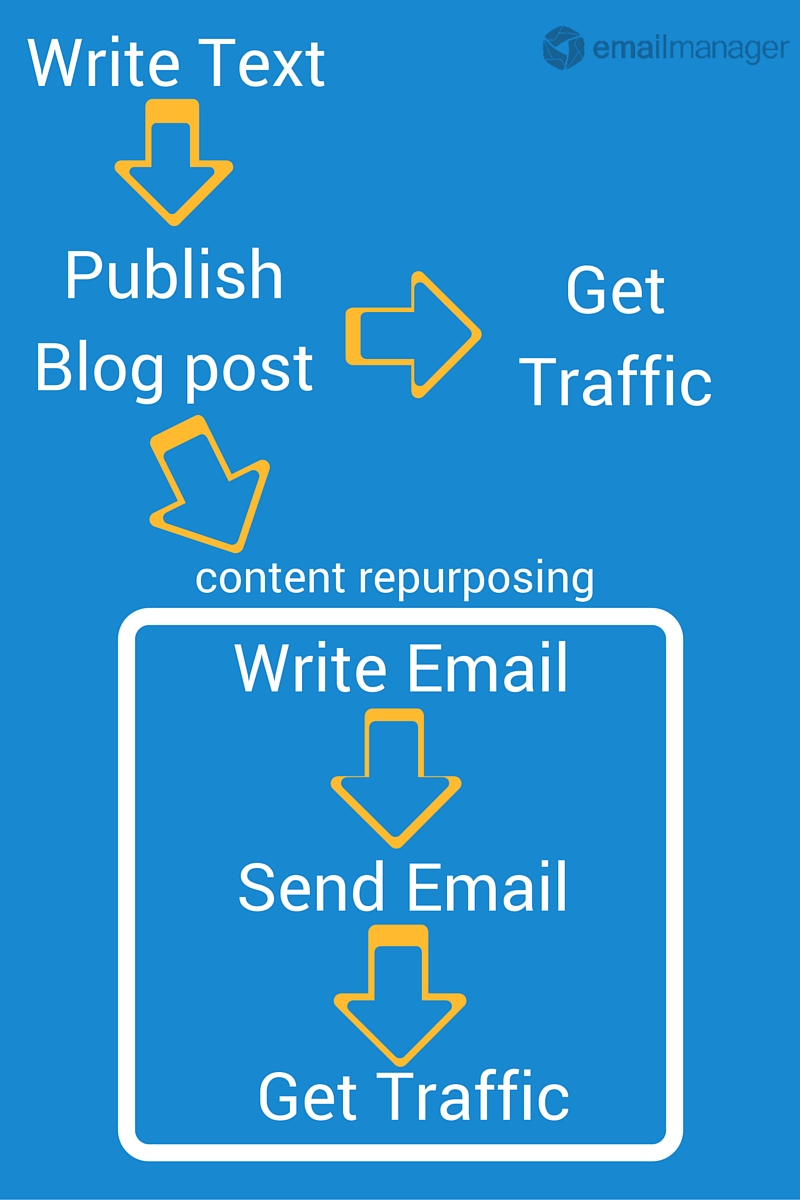Turn blog content into great email marketing campaigns
Published in june, 28 of 2015
Every good marketing professional knows that inbound marketing is a necessity. For some time the strategy to create good and relevant content was only seen as "nice to have", but in 2016 inbound has turned into a must have. Inbound marketing can be simply defined as content that earns the audience's attention. It's an invitation to an ongoing dialogue in which you can communicate with your customers. It can also increase the reach of brands by letting customers share the content within their social or professional circles.
Inbound marketing has basically two directions: content marketing and social media marketing.
When we think of content marketing, blogging comes to mind. The logical is very simple: relevant, helpful blog posts are created to eventually drive traffic to the website's company. The main focus here is to generate leads and create business opportunities, or in other words make people discover your brand or product and make them read to purchased it.
But how to use your blog content to nurture leads and create selling opportunities with your email marketing campaigns? Keep reading and find out. Want to go straight to the point?
- Content marketing, where everything starts
- What about email marketing content?
- Hand in hand: how to use your blog content in your email marketing campaigns
- Repurposing blog content
- 4 benefits of sharing your blog posts on email marketing campaigns
Content marketing, where everything starts
Let's start with the basics. How do people actually find your website page? To make it shorter there are 2 ways: they type your website name or your company name into the browser or into a research web page. This is not very interesting and it doesn't really help you acquiring leads since they already know you; or you could pay for ads, which can be really expensive and won't going to keep your website on their radar for long, after
So what is your way out? Content marketing! The ultimate goal of content marketing is to be so engaging that your lead will eventually purchase your product or service. However to do that you need to attract their interest, increase page views and maintain reader loyalty. There a few ways to achieve that and blogging is one of them. Ultimately your blog post can educate, inform, entertain and/or inspire.
Marketers who prioritize blogging are 13 times more likely to acquire a positive Roi
If you create relevant content not only you'll have more and more pages that are going to be indexed by search engines such as Google and Bing, which means more opportunities of being found by your audience, but also you can actually engage your customer if they like what they're reading. And it is not only that. Take a look at some benefits of blogging:
- Help your social media strategy: blogging can also help you social media strategy. After all, you can always share your blog content into your social media accounts and bring more traffic to your website;
- Convert leads: if you place call-to-action buttons in your blog posts and invite your reader to perform some action, like downloading an ebook or ask for a free trial, for example, you can eventually convert some leads into customers;
- Be a reference: if your content is relevant and helpful for your customers, they will always come to you for answers and guidance. Make sure to answer possible questions about your product or service in your blog content and your customer will feel secure to keep coming back for more information;
- Engage your readers: make your followers and readers engage with your blog posts by asking questions and raising discussions at the end of your blog posts. This will keep them interested in your company and will help you build brand awareness;
- Inbound links: interesting content can also help you with inbound links, an extremely important resource in SEO, search engine optimization techniques. If your blog content is being seen as a reference, your blog posts links will be shared on other website pages and, as a result, your website traffic will increase.
Do not forget that blogging is an ongoing process and will bring results on a long term, so keep your focus on producing high-quality content. By providing exclusive material you will organically grow you website traffic, enhance your customer's loyalty and finally increase your sales rate.
What about email marketing content?
Email marketing may not be considered as part of an inbound strategy but delivering relevant content for subscribers can help your brand awareness and your lead conversion once you will be seen as trustworthy.
According to the Email Experience Council, the success of a good email marketing campaign depends on 3 things: content (40%), audience (40%) and images (20%).
This means that when creating your email marketing campaign you have to consider WHAT you are talking about and to WHO you are talking to. So when talking about the WHAT the number one word to consider is relevance.
Relevance means targeted messages. Your message should be useful for your customers. A research from About.com showed that 71% of consumers trust brands that provide useful info without trying to sell them something. That said, your customer is more likely to buy a product or service from you if his buyer's journey passes through editorial content rather than advertising.
45% of marketers say blogging is their #1 most important content strategy.
But aside from relevance, what makes a good content? Emails are supposed to be an individual experience. Before setting up a campaign ask yourself a few questions: Will my customers want to read this email? What kind of benefit will they get from that? Is it shareable so they can show it to friends and family?
Keep in mind that, if your customers have signed up to receive your emails, they are interested in being educated on some topic or need help to solve a problem. They are explicitly requesting more information.
Hand in hand: how to use your blog content in your email marketing campaigns
A good away to deliver good and relevant content to your customers is sharing your blog posts in your newsletter emails. This way you can drive more traffic to your blog and your company's website using your email marketing campaign.
Email allows you to effectively communicate with readers on a more intimate level, build trust with your audience, and gives you a tool for offering relevant content to your audience.
But how to combine your blog content and email in an interesting way? After all, copy and paste is not an option here. Let us give you some insights:
- First and most simple tactic: when you publish a new blog post, send a link for it to your contact list. Create one or two magnet headlines and add the link to your blog posts so they can read it right away. Fresh content is the fuel that drives the blogosphere; it keeps readers coming back to your blog.
- On the other hand, add a signup form at the bottom of your blog posts and offer some sort of incentive to the customer that subscribes. For example, updates, monthly newsletters or access to exclusive content.
- Build an editorial calendar for your blog and email marketing strategy, so you can make them work together. This will help you when creating content for emails, for example, as you can see what's being published on your blog, and vice-versa.
- Promote your guest posts. If you have guest posts, why not letting your audience know? This way you can give them different insights on relevant topics and introduce them to new writers and websites that they might not know of. Once again it helps build your trust within your customers.
- Use old blog posts as magnets. Find some older but popular posts and use them as magnets to get some new subscribers. We will talk further about this later.
- Have you ever considered to create an autoresponder series to leverage already-existing content? You can use some of your old and popular posts for that. For example, you can create and advertise some sort of free course using the content of specific posts. You just have to copy them into newsletter templates and make it as a series of emails sent once a visitor subscribes to your newsletter.
- Create dedicated campaigns. Segment your list and send some blog content that may be interesting for a particular group of customers. Doing that you can create value for your content and engage customers according to their interests.
Remember that Sonia Simone in the Content Marketing Know-It-All) once said that email marketing and blogging serve different purposes, and a smart content marketing strategy will usually include both.
Repurposing blog content
Consider repurposing your blog content to create new, engaging email campaigns. You can always add some new info or reformat your content for different channels. Think of new angles that you can take on the same topic. Consider elaborating on the topic and then linking back to your old blog posts. Create other assets than text to communicate your message.
For example, why not create email campaigns with infographics, webinars or ebooks from an old successful blog post? Do your research and find out which posts have been highly rated and find new ways to share them

4 benefits of sharing your blog posts on email marketing campaigns
Most of
Take Facebook for
- The timing: your email will be waiting in your customer inbox until he reads it, or until he deletes it. Make sure to have great appealing content so that your customer open your email
- Targeted audience: your email list is filled with contacts that want to hear from you. Take advantage of that and send the most interesting content
- Ongoing audience: most of the times people who comes to your blog because of social media or search engines are usually just one visit wonders. But if you manage to make them subscribe to your mailing list, you can reach them whenever you like. Keep that in mind to give them substantial content that keeps making them come back.
- Keep track of your results: using email marketing you can track your results like open rates, click-through rates, etc. So you can find out how your blog posts are performing, if the subject lines worked, if your audience prefers images or textual content in newsletters, etc.
Do not forget to use all your social media accounts to help promote your blog posts and newsletters. Your customer is much more likely to be receptive if he hears from you from different channels. Make sure your email,
You can always create different tactics to promote your content. After all, combining blogging and email marketing should be part of your marketing strategy. Remember that creating and publishing the content is just the start of the journey, the hard work comes afterward.
The success of your blog posts will determine the success of your website and eventually will reflect on your sales. Do not underestimate the power of your cross channels marketing strategy.